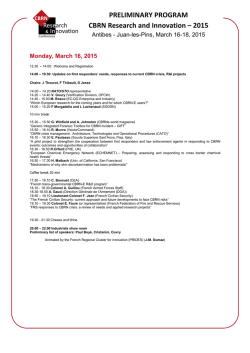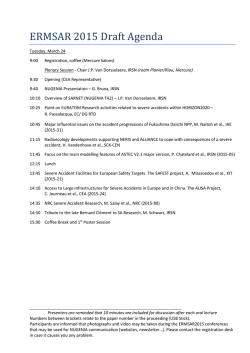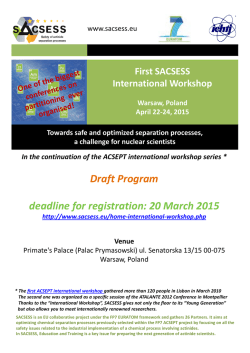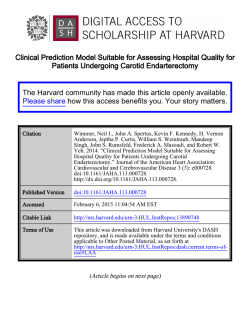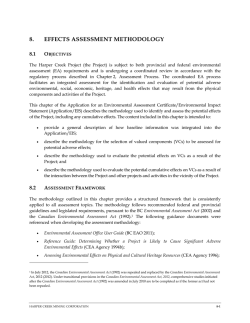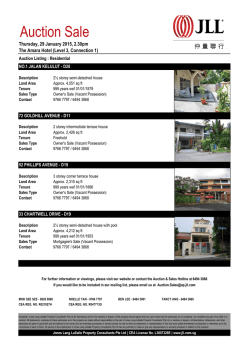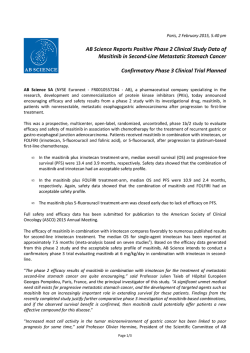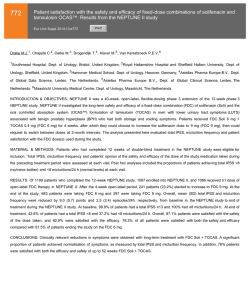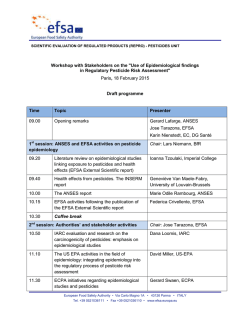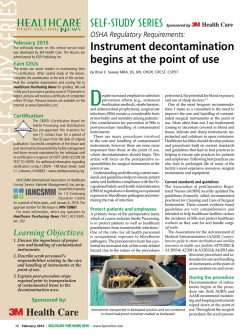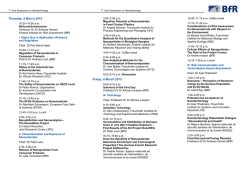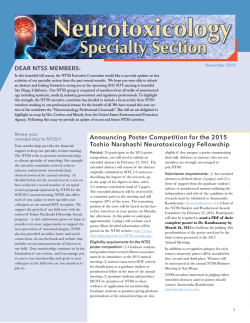
PRELIMINARY PROGRAM CBRN Research and Innovation – 2015
PRELIMINARY PROGRAM CBRN Research and Innovation – 2015 Antibes - Juan-les-Pins, March 16-18, 2015 Parallel sessions Tuesday, March 17, 2015 14.15 – 16.00 Medical Countermeasures (part 3) • R. Hammamieh, US Army Center For Environmental Health Research, USA “Temporal Progression of Pneumonic Plague in Blood of Nonhuman Primate: A Transcriptomic Analysis” • M. Joosen, TNO Department CBRN Protection, The Netherlands “The impact of skin decontamination on the time for effective treatment of low volatile nerve agents” • F. Dhote, Armed Forces Biomedical Research Institute , France “Efficacy of HI6 dimethanesulfonate (combined with atropine and avizafone) by the intramuscular route, in VR-intoxicated cynomolgus monkeys” • L. Wegner, Bavarian Nordic A/S, Denmark “From Smallpox to Ebola: Utilizing the MVA-BN® Vaccine Platform to Address National Security and Public Health Threats” • X. Brazzolotto, Armed Forces Biomedical Research Institute , France “Biochemical and Structural Study of a Self-Reactivating Butyrylcholinesterase after V-type Nerve Agent Inhibition” • R. Baati, Strasbourg University, ICPEES, France “Discovery of a new class of tetrahydroacridine hybrid reactivators of nerve agentinhibited human acetylcholinesterase” • S. Simon, CEA, France “Neutralizing Antibodies Against Ricin Toxin and Mechanism of Action” 16.00 – 16.30 Coffee break 16.30 – 18.00 Medical Countermeasures (part 4) • A.G. Calas, Armed Forces Biomedical Research Institute , France “In vivo efficacy assessment of two uncharged reactivators of VX-inhibited acetylcholinesterase in Mouse compared to two reference oximes: HI-6 and pralidoxime” • K. Kuca, Faculty of Military Health Sciences University of Defence, Czech Republic “Modified bisquaternary monooximes were found to be effective reactivators of human AChE inhibited by organophosphates” • J. Bzdrenga, Aix-Marseille University, France “Study and development of a bacterial virulence inhibitor by quorum quenching” • T. Wille, Task Force Medical Chemical Defence of the Bundeswehr, Bundeswehr Institute of Pharmacology and Toxicology, Germany “Concept to support medical service, deployed troops and political and military decision makers in case of a chemical agent attack with medical expertise” • S. Mikhalovsky, Brighton University, UK “Medical Adsorbents for Protection against CBRN Accidents” PRELIMINARY PROGRAM CBRN Research and Innovation – 2015 Antibes - Juan-les-Pins, March 16-18, 2015 Wednesday, March 18, 2015 08.00 – 10.15 Protection & Decontamination M. Watanabe, Research Center of Supercritical Fluid Technology, Tohoku University, Japan “Alkali metal (including Cs) separation by chelating method in supercritical CO2 and adsorption on charcoal” • S. Grivès, IRSN, France “Evaluation of the efficacy and cutaneous toxicity of a calixarene topical formulation for the treatment of superficial wounds contaminated by uranium” • J. Voigt, Bundeswehr Research Institute for Protective Technologies and NBC Protection, Germany “Solar light-activated photocatalysts and functionalized textiles for selfdecontaminating individual protection against toxic agents” • T. Kadar, Institute for Biological Research, Israel “Dermostyx (IB1) – High efficacy topical skin protectant against percutaneous toxic agents” • I. Shortman, Defence Science and Technology Laboratory (Dstl), UK “Development of improved test methods to evaluate CWA contact hazards and personal decontamination efficacy” • J. Larner, Research Centre for Topical Drug Delivery and Toxicology, UK “Use of LC-MS urinalysis to measure systemic exposure to methyl salicylate CW simulant in a human volunteer decontamination trial” • S. Shetage, Research Centre for Topical Drug Delivery and Toxicology, UK “HPLC-APCI-MS profiling of residual skin surface components: ‘Sebomics’” • A. Salerno, University of Lyon 1, Laboratory of automatic control and process engineering, France “In Vitro Skin Decontamination of the Organophosphorus Pesticide Paraoxon with Nanometric Cerium Oxide CeO2” • D. Daudé, Gene&GreenTech, France “Engineering hyperthermostable enzymes for external decontamination of organophosphate chemicals” • 10.30 – 13.00 Detection (part 3) • S. Delannoy, ANSES, France “Use of whole genome sequencing and High throughput qPCR for identification of pertinent genetic markers associated with enterohemorrhagic E. coli : an interesting approach to improve tracking and tracing of accidental and deliberate contamination of food and water samples with EHECs” • M. Ansaldi, Laboratoire de Chimie Bactérienne CNRS-Aix Marseille University, France “Phage-based fluorescent biosensors to specifically detect enterobacteria in water” • K. Helmi, Veolia, France “Microbiological monitoring of drinking water production process using flow cytometry: a reliable tool for active management” • T. Bernard, Fraunhofer IOSB, Germany “SAFEWATER - Innovative tools for the detection and mitigation of CBRN related contamination events of drinking water” PRELIMINARY PROGRAM CBRN Research and Innovation – 2015 Antibes - Juan-les-Pins, March 16-18, 2015 • R. DenBulk, CEA, France “FlowPad, a generic microfluidics platform for automated sample preparation and qPCR detection” • F. Becher, CEA, France “Multiplex absolute quantification of microbial and plant toxins in complex matrices using high resolution targeted mass spectrometry and isotopically labeled protein standards” • J-M. Elalouf, CEA, France “Extraction of trace amounts of degraded DNA for high-throughput sequencing and reconstruction of complete genomes” • C. Feraudet Tarisse, CEA, France “Detection of Clostridial epsilon toxin in biological matrices by immunoassay and immunochromatography” • E. Schultz, CEA, France “Rapid label-free identification of bacterial pathogens with optical elastic scattering” • S. Jerome, National Physical Laboratory, United Kingdom “Retaining a global resource of Plutonium-244” 12.45 – 14.00 Lunch – Poster session & poster prize 14.00 – 16.30 Detection (part 4) • J. Vanhomwegen, Institut Pasteur, France “Rapid diagnostic tools for point-of-care testing of Ebola virus disease” • G. Girault, ANSES, France “Using whole genome SNP discovery to genotype Anthrax” • J-C. Baritaux, CEA, France “An experimental study of monitoring single bacteria in non-ideal conditions using Raman spectroscopy” • A. Carella, CEA, France “Colorimetric papers sensitive to Sarin in the gas phase” • A. Alvarez, CIEMAT, Spain “Spanish collaboration for improving solutions against CBRN threat” • R. Araoz, CNRS, Laboratoire de Neurobiologie et Développement, France “Bioassays development for detecting fast acting neurotoxins targeting nicotinic acetylcholine receptors” • P. Armand, CEA, France “CERES® CBRN-E – A fast response modelling and decision-support system to face CBRN-E threats” • S. Procureur, CEA, France “Muon tomography for homeland security with multiplexed Micromegas detectors” • K. Boudergui, CEA, France “Plastic scintillator based technic to provide Helium 3 free neutron detectors for Radiation Portal Monitor application” • J-P. Monet, SDIS13, France “Can robots enhance crisis management? Cases Study of UGVs and UAVs use for civil protection emergencies”
© Copyright 2026
